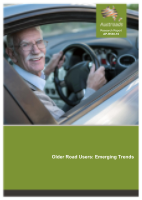Road Safety

- Publication no: AP-R530-16
- ISBN: 978-1-925451-39-9
- Published: 20 October 2016
- PDF (free) Download
This report identifies trends in crash involvement amongst older road users (aged 75+).
The project incorporated a literature review; analysis of 10 years of crash data from every jurisdiction in Australia and New Zealand; analysis of three years of detailed hospital injury data for older road users in South Australia; analysis of the contributing factors in older road user crashes examined using the Centre for Automotive Safety Research in-depth investigation method; consultations with representatives of all jurisdictions in Australia and New Zealand; and a summary of relevant sections of road safety strategies in a sample of international jurisdictions.
The report provides policy recommendations and describes crash countermeasures relevant to older road users.
- Summary
- Data
- Injury Risk
- The Risk to Older Pedestrians
- Crash Factors
- Alterations to driving habits and licence status
- Co-Operation Between Government Departments
- 1. Literature Review
- 1.1. Method
- 1.2. Introduction
- 1.3. Older Drivers
- 1.3.1. Crashes Involving Older Drivers
- 1.3.2. Mobility Issues
- 1.3.3. Driving Cessation
- 1.4. Public Transport
- 1.5. Older Pedestrians
- 1.5.1. The Safety of Older Pedestrians
- 1.6. Mobility Scooters
- 1.6.1. The Safety of Older Mobility Scooter Users
- 1.7. Pedal Cyclists and Motorcyclists
- 1.7.1. The Safety of Older Pedal Cyclists
- 1.7.2. The Safety of Older Motorcyclists
- 1.8. Increasing Travel by Older Adults and Their Preference for Driving Themselves
- 1.9. Overall Summary and Key Points
- 2. Older Road User Data Analysis
- 2.1. Introduction
- 2.2. Method of Analysis
- 2.3. Overall Data
- 2.3.1. Number of Crashes
- 2.3.2. A Note On Active Crash Participants with an Unknown Age
- 2.3.3. Active Units in Crashes
- 2.3.4. Active Participants in Crashes
- 2.3.5. Total Crash Involvement Per Year
- 2.3.6. Crash Rates Per Head of Population
- 2.3.7. Crash Rates Per Licence Holder
- 2.3.8. Unit Type by Crash Participant Age
- 2.3.9. Injury Risk If Involved in an Injury Crash
- 2.3.10. Active Participant Sex
- 2.3.11. Responsibility for The Crash
- 2.3.12. Day of Week
- 2.3.13. Time of Day
- 2.3.14. Lighting at the Time of the Crash
- 2.3.15. Speed Limit
- 2.3.16. Weather at the Time of the Crash
- 2.3.17. Road Wetness at the Time of the Crash
- 2.3.18. Road Surface Type
- 2.3.19. Crash Type
- 2.3.20. Summary
- 2.4. Conclusions
- 2.4.1. Limitations
- 2.4.2. Overall Crash Numbers and Trauma
- 2.4.3. Unit Type
- 2.4.4. Injuries and Fatalities
- 2.4.5. Other Crash Characteristics
- A Note On Statistical Significance
- 3. Analysis of In-Depth Crash Data
- 3.1. Introduction
- 3.2. Crash Investigation Method
- 3.3. Limitations
- 3.4. Results
- 3.4.1. General
- 3.4.2. Right Angle
- 3.4.3. Pedestrian
- 3.4.4. Right Turn in Front
- 3.4.5. Single Vehicle
- 3.4.6. Rear End
- 3.4.7. U-turn
- 3.4.8. Head On
- 3.4.9. Other
- 3.5. Discussion
- 4. Analysis of a Sample of Hospitalised Road Users
- 4.1. Introduction
- 4.2. Method
- 4.2.1. Case Selection
- 4.2.2. Medical Data
- 4.2.3. Police-Reported Crash Data
- 4.2.4. Licensing Records
- 4.2.5. Results of Blood Tests for Alcohol and Drugs
- 4.2.6. Interviews
- 4.2.7. Limitations
- 4.3. Results
- 4.3.1. 75+ Sample
- 4.3.2. 60-74 Sample
- 4.3.3. Results of The Interview Study with 60 Surviving Hospitalised Older Drivers
- 4.4. Summary and Conclusions
- 5. Consultations with Stakeholders
- 5.1. Introduction
- 5.2. Method
- 5.3. Limitations
- 5.4. Australian and New Zealand Consultations
- 5.4.1. Is the Ageing Population Considered a Transport Safety Issue?
- 5.4.2. Countermeasures for Older Road User Crashes
- 5.4.3. Other Relevant Issues
- 5.5. International Road Safety Strategies
- 5.5.1. Netherlands
- 5.5.2. Norway
- 5.5.3. United Kingdom
- 5.5.4. United States
- 5.6. Conclusions
- 6. Overall Conclusions and Recommendations
- 6.1. Synthesis of Results and Conclusions
- 6.1.1. Data
- 6.1.2. Injury Risk
- 6.1.3. The Risk to Older Pedestrians
- 6.1.4. Crash Factors
- 6.1.5. Alterations to Driving Habits and Licence Status
- 6.1.6. Co-Operation Between Government Departments
- A Note On Medical Fitness to Drive
- References
- Appendix A Crash Data Tables
- Appendix B Definitions for Coding Accidents (DCA Codes)
